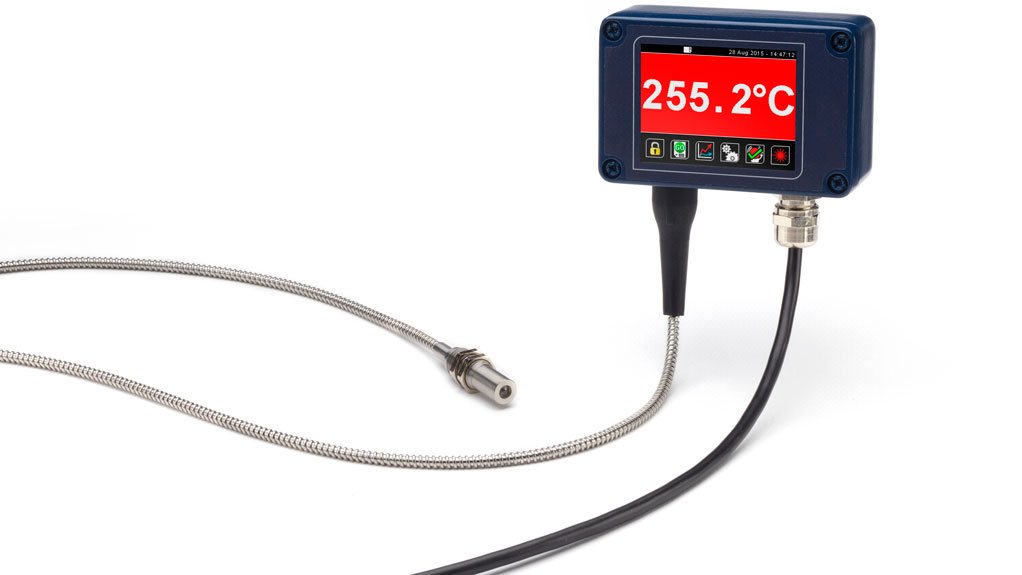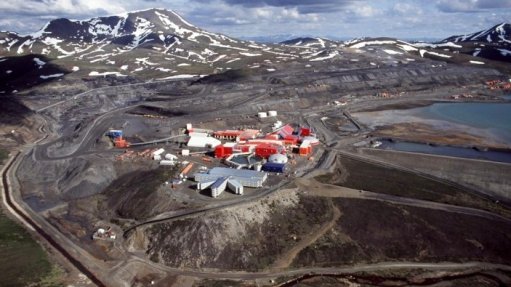Fibre-optic pyrometer offers South Africa greater accuracy


FIBRE-MINI PYROMETER The fibre-optic sensing head withstands up to 200 °C ambient temperature
The South African minerals and metals processing industry has yet to take advantage of the fibre-optic Calex Fibre-Mini pyrometer, compared with the response from international markets, which has been favourable.
The pyrometer, used to measure temperatures of reflective metals, was developed by UK-based measurement and control equipment supplier Calex Electronics.
The Fibre-Mini, launched in October last year and introduced to the South African market in February, is distributed by Johannesburg-based industrial equipment provider ASSTech Process Electronics & Instrumentation, which was awarded sole distribution rights for Southern Africa for Calex products in 2014.
The company notes that temperature monitoring is important during metals processing because it enables companies to optimise the refining and/or smelting process by ensuring that the furnace is operated at the correct temperature. This, in turn, reduces energy consumption, as maintaining excessive, unnecessarily high temperatures consumes and, ultimately, wastes more energy.
ASSTech MD Anastas Schnippenkotter says measuring the temperatures of reflective metals is challenging because their reflective nature distorts readings that are already difficult to obtain in and around furnaces that have high ambient tempera- tures. He adds that achieving accurate readings is especially difficult when using noncontact sensors.
“The use of a hand-held infrared thermo- meter can result in inaccurate readings, owing to a technician’s hand movement, as changing angles can affect the reading. Readings that do not reflect a plausible temperature, due to differing surface and ambient temperatures, can also be obtained, especially when technicians are aiming the thermometer directly into a furnace,” Schnippenkotter explains.
He comments that general-purpose, long-wavelength temperature guns are also not suitable for use on metals because they are more susceptible to errors than shortwave sensors if the emissivity setting is incorrect. “A small emissivity error can cause a big measurement discrepancy.”
Further, Schnippenkotter notes that the area surrounding the furnace is a harsh environment in which to mount an infrared sensor, as the ambient temperature commonly exceeds 150 ºC, thereby ruling out most temperature sensor options.
“The solution is to use a short-wave pyrometer such as the Fibre-Mini.”
He explains that the Fibre-Mini’s fibre- optic sensing head withstands up to 200 ºC ambient temperature, making it ideal for mounting near furnaces, while the lack of electronics in the sensor head make it immune to electromagnetic interference in applications, such as induction heating.
Schnippenkotter says the reflected energy compensation setting of the Fibre-Mini allows for an accurate reading when measuring reflective objects inside furnaces. “Simply enter the temperature of the furnace interior and the sensor will compensate for the reflection, for a more accurate reading. This can also be adjusted automatically on Modbus models for maximum accuracy during heating and cooling cycles.”
He explains that, when measuring the temperature of a reflective object, the adjustable emissivity setting helps ensure an accurate reading, as this setting tells the sensor what proportion of the infrared energy is emitted and reflected by the target.
The reflective energy compensation setting helps ensure that the reading is accurate if there is a significant amount of reflected infrared radiation from other hot surfaces, such as the sides of an oven or a furnace.
Other features of the Fibre-Mini include a laser aiming-light that illuminates the measurement area, showing the location and the size of the measuring spot; a large, full-colour temperature display with data logging; and a choice of 4 mA to 20 mA or RS485 Modbus outputs for connection to other process instrumentation. The Fibre-Mini also has a fully configurable touch-screen display.
The pyrometers are available in temperature ranges from 250 ºC to 2 000 ºC to cater for varying surface areas and distances. The flexible fibre-optic cable, available in lengths of 3.5 m or 10 m, allows for the sensing head to be fed through trunking for safety and aesthetic purposes. Additionally, the short measurement wavelength enables the sensor to measure through ordinary viewpoints made of glass or quartz, as well as specialist infrared- transmissive materials.
“The Fibre-Mini is a big change for users accustomed to bulky, expensive cooled pyrometers,” says Schnippenkotter. He adds that Calex has reported that, in addition to the pyrometer’s ability to withstand high temperatures without cooling, international customers “like the small size of the sensing head and how easily it can fit through an existing conduit when routing the fibre-optic cable during installation”.
Moreover, Schnippenkotter states that, as far as he is aware, “there aren’t any similar products on the market, or at least there isn’t anything as small as the Fibre-Mini that can operate at up to 2 000 ºC”.
Schnippenkotter concludes that ASSTech, a specialist supplier of process monitoring control instrumentation and sensors, offers end-to-end solutions, including technical support and installation.
Article Enquiry
Email Article
Save Article
Feedback
To advertise email advertising@creamermedia.co.za or click here
Announcements
What's On
Subscribe to improve your user experience...
Option 1 (equivalent of R125 a month):
Receive a weekly copy of Creamer Media's Engineering News & Mining Weekly magazine
(print copy for those in South Africa and e-magazine for those outside of South Africa)
Receive daily email newsletters
Access to full search results
Access archive of magazine back copies
Access to Projects in Progress
Access to ONE Research Report of your choice in PDF format
Option 2 (equivalent of R375 a month):
All benefits from Option 1
PLUS
Access to Creamer Media's Research Channel Africa for ALL Research Reports, in PDF format, on various industrial and mining sectors
including Electricity; Water; Energy Transition; Hydrogen; Roads, Rail and Ports; Coal; Gold; Platinum; Battery Metals; etc.
Already a subscriber?
Forgotten your password?
Receive weekly copy of Creamer Media's Engineering News & Mining Weekly magazine (print copy for those in South Africa and e-magazine for those outside of South Africa)
➕
Recieve daily email newsletters
➕
Access to full search results
➕
Access archive of magazine back copies
➕
Access to Projects in Progress
➕
Access to ONE Research Report of your choice in PDF format
RESEARCH CHANNEL AFRICA
R4500 (equivalent of R375 a month)
SUBSCRIBEAll benefits from Option 1
➕
Access to Creamer Media's Research Channel Africa for ALL Research Reports on various industrial and mining sectors, in PDF format, including on:
Electricity
➕
Water
➕
Energy Transition
➕
Hydrogen
➕
Roads, Rail and Ports
➕
Coal
➕
Gold
➕
Platinum
➕
Battery Metals
➕
etc.
Receive all benefits from Option 1 or Option 2 delivered to numerous people at your company
➕
Multiple User names and Passwords for simultaneous log-ins
➕
Intranet integration access to all in your organisation



















